The 27-inch Apple iMac Review (2011)
by Anand Lal Shimpi on May 27, 2011 2:30 AM ESTPower, Thermals and Noise
I started this review complaining about how loud the 15-inch MacBook Pro gets, but with 32x the physical volume the 27-inch iMac is near silent. Even under load the system is very quiet, almost too quiet. Apple chose a very lax fan profile which results in some very high external temperatures. The iMac takes in cool air from the bottom of the display and exhausts it up top behind the display. Playing Half Life 2 Episode Two I measured a maximum surface temperature of 125F at the exhaust vent. Again, unless you're doing something weird with the iMac on your lap this isn't an issue. Keep in mind that the Sandy Bridge CPU in the 15-inch MacBook Pro carries a 45W TDP and what's in the iMac is either 65W or 95W. Add in a larger, hotter hard drive and potentially a beefier GPU and you have a recipe for a pretty warm machine.
| 2011 iMac Power Usage | ||||||
| 27-inch iMac (Mid 2011) | Idle | Cinebench R11.5 | Half Life 2 Episode Two | |||
| Minimum Brightness | 54.1W | 108.3W | 149.0W | |||
| 50% Brightness | 86.6W | 141.6W | 180.0W | |||
| 100% Brightness | 144.5W | 198.3W | 240.0W | |||
With a large integrated display power consumption obviously varies depending on brightness. At idle, power consumption ranges from 54W to 144W. Under load the range quickly gets ever higher. I measured max system power consumption at 240W running Half Life 2 Episode Two.
Power consumption isn't out of control but you've got a billion transistor CPU, a 1.7B transistor GPU and a high resolution 27-inch display + backlight - it's going to draw some power.
Performance
Having never previously been a fan of the iMac, I don't actually have any historical performance data to compare to. What I do have however are scores from Mac Pros and of course the MacBook/MacBook Pro lines from the past couple of years.
Adobe Photoshop CS4 Performance
The Retouch Artists Speed Test we use for our CPU testing under Windows also works under OS X. We're running the exact same benchmark here, basically performing a bunch of image manipulations and filters and timing the entire process.
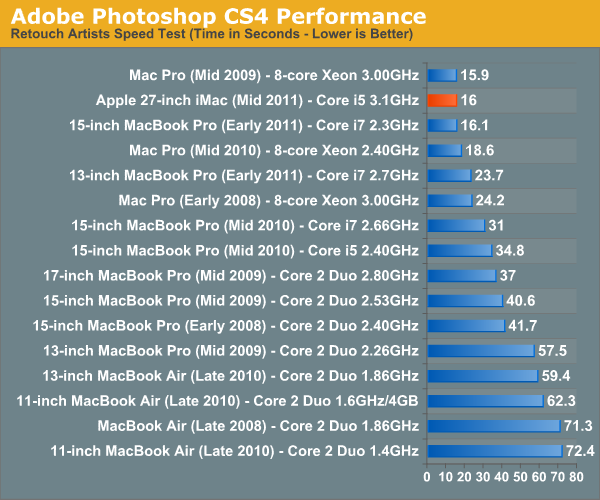
The high-end 27-inch iMac is a very capable Photoshop machine. A hair faster than the new MacBook Pro, the iMac delivers the same performance as an 8-core Mac Pro from 2009 or 2010.
Aperture 2 RAW Import
For my Aperture test I simply timed how long it took to import 203 12MP RAW images into the library.
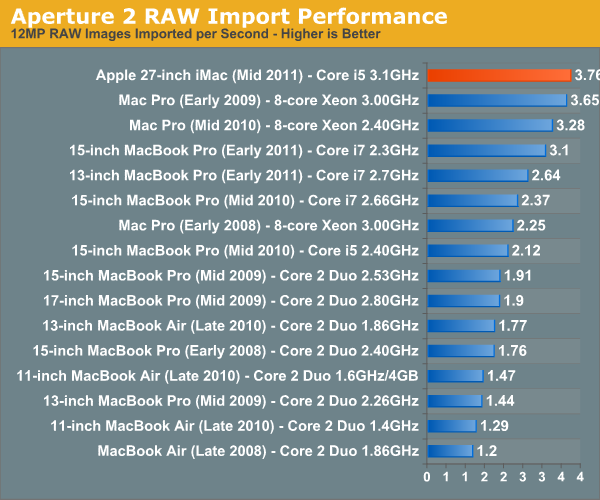
We have a new winner here! The MacBook Pros were always limited by their slower 2.5" hard drive, but the iMac with Sandy Bridge in additional to a speedier disk give us better image import performance than the '09 and '10 Mac Pros. I told you this thing was fast.
Cinebench R10 & 11.5
I’m a fan of the Cinebench tests because they lets me show off both single and multithreaded performance in the same workload. First, the single threaded performance:
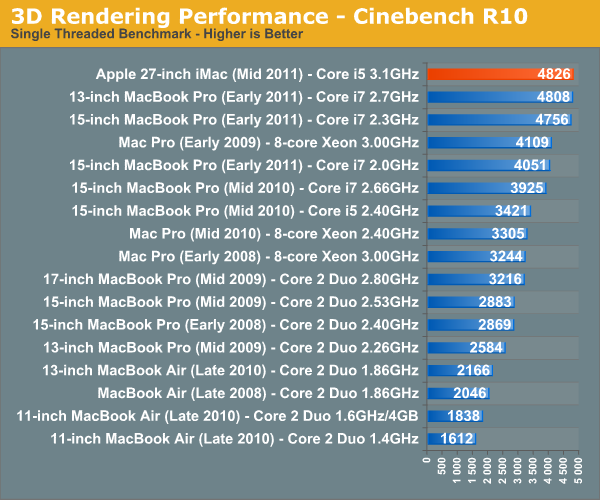
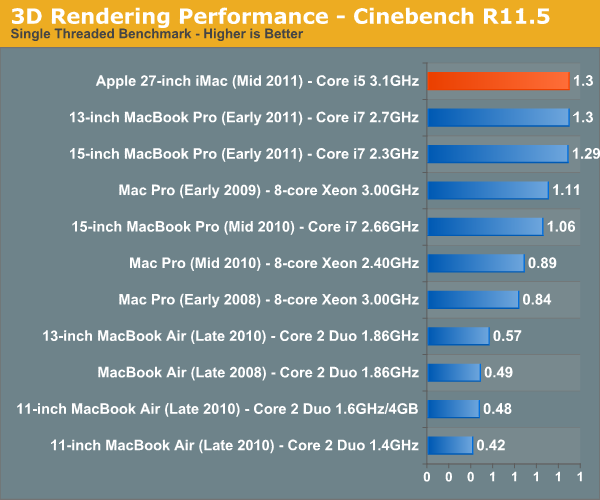
Sandy Bridge quad-core CPUs make no sacrifices. You get excellent single threaded performance which means general OS usage, launching applications and even rendering most web pages happens as fast as physically possible as the other cores are power gated and asleep. Start multitasking however and you'll see the Core i5 in this machine is no slouch:
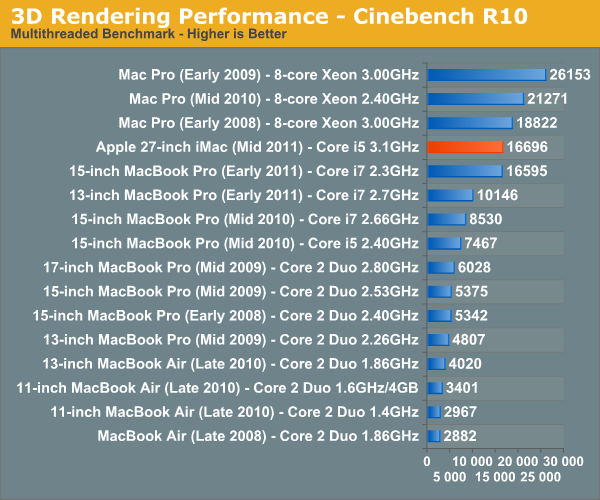
There's still no replacement for more cores when it comes to heavily threaded applications, the past three years of 8-core Mac Pros are still faster than the new 27-inch iMac here. I suspect the upgraded Core i7 would at least let the iMac beat the 2008 Mac Pro thanks to Hyper Threading, but the other two systems are simply out of reach. For those users, you're better off waiting for the Sandy Bridge-E Mac Pro update expected sometime in Q4.
You'll notice in Cinebench R10 the 15-inch MacBook Pro is nipping at the heels of the new iMac. Chalk that up to the larger L3 cache and Hyper Threading, both advantages enjoyed by the MacBook Pro. Look at what those advantages do in Cinebench R11.5's multithreaded test:
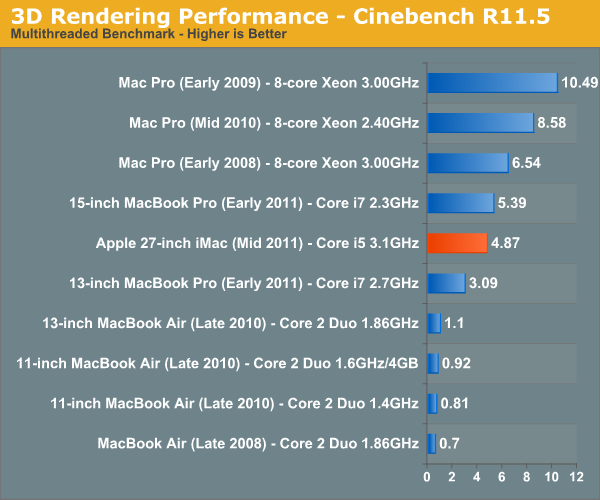
Here the MacBook Pro actually gains on the iMac. More threads and more cache are better suited for the Cinebench workload. If you do a lot of offline 3D rendering and you want the iMac, I'd suggest upgrading to the Core i7-2600 that Apple offers. You get a not insignificant boost in clock speed but more importantly, Intel switches on Hyper Threading which gives you twice as many threads.
Quicktime H.264 Video Encoding
Our final benchmark is more consumer focused. Here I'm taking an XviD and converting it to an iPhone-supported H.264 format.

QuickTime doesn't make tremendous use of all cores all of the time, and thus the MacBook Pro loses its threading advantage. The iMac is our new champion of this test.










139 Comments
View All Comments
meorah - Friday, May 27, 2011 - link
"Example: My 2007 24" imac was ~£1200. Resale value for similar spec on ebay today: ~£650-700. That means it's cost me around £500-£550 over 4 years, roughly the cost of a low-end desktop with an OK screen."its cost to you was 1200. it has depreciated around 500-550 over 4 years.
If you were trying to lease an imac for 500-550 over 4 years, then it would have cost you 500-550 over 4 years, but you bought it so that's not right.
psonice - Friday, May 27, 2011 - link
What difference does it make? At some point (probably soon) I'll sell it and buy a new box. At that point it'll have cost me 500-550, for 4 years of use.KoolAidMan1 - Friday, May 27, 2011 - link
Depreciation on PC parts is much worse. I sell my old PC components on roughly the same schedule as my Macs, every 2-3 years, and with my Mac sales it is more than enough to help pay for its replacement. With my old PC parts, not so much. :)KoolAidMan1 - Friday, May 27, 2011 - link
You nailed it. You aren't "losing a good monitor" when you sell your old iMac for a new one, you're getting a better monitor with the major revisions.The 24" iMac had a great H-IPS panel in it, but the upgrade from that to the 27" IPS panels in the new iMacs is well worth the upgrade. Combine that with high resale value on Macs and its a pretty good deal, ridiculously easy upgrade too (just pack the old one in the box it came in).
DarkShift - Saturday, May 28, 2011 - link
"Basically, macs are surprisingly cheap when you factor in the resale value. You either keep them long term (and they pay for themselves then anyway), or you sell after a few years and get half your money back."That's surpsrising considering that Mac's are mostly underpowered even as new. 650£ for 2007 iMac is way too much considering how slow it must be.
I have noticed, that most people who happily buy macs really don't know anything about tech stuff. Many still think that there must be something in Apple hardware that's better than in PC's while they often share same components.
For comparison, my self build PC workstation runs circles around these iMac's and it cost me less. And that is with Intel i7 2600K @ 4.6Ghz, 3 SSD drives,16GB ddr3 ram, Blue ray and USB 3.0 ports. And absolutely no blue screens after 5 months use. ;)
Benchmarked results:
Retouch artics Photoshop (with CS5): 9,5s
Cinebench R10 Rendering single: 7690
Cinebench R10 Rendering multi: 30536
Performance is the most important thing for pro users at it tells how fast you get your job done. Other issues are mostly cosmetic as most pro software is found for both Mac and PC. You get paid for using the tools, not for using them on specific OS.
jonwd7 - Friday, May 27, 2011 - link
Unless I am mistaken, your claim that the SSD in the 2011 iMac is the same old Toshiba one they've been using is pure speculation, but you don't treat it like so. If you attempt to order a new 2011 iMac with an SSD, the shipping date gets moved back significantly. There is some possibility that this is because they are switching to a newer, possibly Samsung-branded SSD. It being Samsung is just a rumor I believe, based on what they used in the newest MacBook Airs.kevith - Friday, May 27, 2011 - link
I think it´s not a drawback, but quite the opposite, when a laptop or an all-in-one is fitted with too little RAM and/or too little HDD/SSD, since it´s the only things you can upgrade yourself.And that always cheaper than the price-premium the manufacturer will charge, certainly if the manufacturer is Apple...
So for my part I always look for laptops without SSD and with as little memory as possible.
tech6 - Friday, May 27, 2011 - link
Looks like a nice system that is held back by a design problem. Most laptops have easy access service panels for RAM and disk upgrades or replacements and the lack of this feature would rule this system out for me. That's a pity as it looks good and is reasonable value but if you have to remove the LCD and board just to get at the disk, that is just plain stupid industrial design.Johnmcl7 - Friday, May 27, 2011 - link
It's worse than stupid, it's entirely intentional as you're not supposed to repair or upgrade your iMac you're supposed to buy a new one. I cannot stand Imacs for their appalling internal design and I'm surprised a tech site like this can still praise Imacs given that laptops a fraction of the size are a two second job to get the drive out so there's absolutely no reason for the Imac to be any different.Even putting the Imac's terrible design aside, I'm not a fan of all in one PCs as I struggle to see the point unless you're really, really tight on space. You're essentially getting the disadvantages of both a laptop and a desktop but none of the advantages as the system is neither portable nor flexible/upgradeable or offering topend performance. I have a Dell U2711 which thanks to having just about every input possible can currently hook up to a few different machines and I expect it to last far beyond the current desktop PC it's mainly hooked up to. This new Imac seems even worse for use beyond the builtin computer with a very limited video input.
John
wintermute000 - Friday, May 27, 2011 - link
The main issue is that its still laptop-esque price/performance for a desktop.The lack of an apple tower or upgradable box is quite astounding. They could just keep it single socket, 8Gb RAM or under, and consumer (not pro variant) gfx cards.
2k USD can buy you a liquid cooled quad-core sandy bridge, mid-high GPU, SSD rig + a decent 24" IPS display with a spare 4 or so Tb of spinning platter storage. No contest except for OSX tax if your apps demand OSX. Back in the XP days the OS was worth the markup but no more IMO